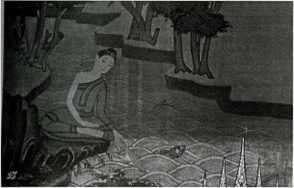ayaṃ loko paraloko
jānatā suppakāsito,
yañ-ca Mārena sampattaṃ
appattaṃ yañ-ca Maccunā.
sabbaṃ lokaṃ abhiññāya
sambuddhena pajānatā
vivataṃ amatadvāraṃ
khemaṃ nibbānapattiyā.
chinnaṃ pāpimato sotaṃ
viddhastaṃ vinalīkataṃ,
pāmujjabahulā hotha,
khemaṃ patt’ attha bhikkhavo ti.Both this world and the world beyond
Have been revealed by him who knows:
What’s within the reach of Mara,
And also what’s beyond his reach.
Fully knowing all of the world,
The wise one, by awakening,
Has opened the door to non-death,
Which safely reaches nibbāna.
Mara’s stream is penetrated!
Disrupted, and cleared of its weeds.
Be greatly joyful therefore, monks,
—For safety is within your reach.
This verse comes at the end of the Shorter Discourse on the Cowherd (Majjhima Nikāya 34), where the Buddha develops the simile of a herd of cows getting safely across the ford of a raging river.
The strong old bulls plunge straight in and show the way to the others—these are likened to the arahants who make their way across the flood of death to the safety of the further shore. The other members of the herd also make their way across according to their capabilities, from the heifers and young oxen to the youngsters and the newborn calves, just as the various groups of Buddhist followers attain the goal in due course by different methods.
The Buddha, of course, is the one who has first “cut” (chinna) the current of the river with his wisdom to show the way to the safety of nibbāna. It is hard to know how best to translate this word in this context. Its meaning is clear enough, being simply a form of the verb “to cut.” But how does one cut a stream? We immediately think of “cutting off” the flow of water, but this is not what happens when a river is forded.
 Bhikkhus Ñāṇamoli and Bodhi throughout their translation of this discourse speak of the stream as being “breasted.” This term expresses well the sense in which one boldly stands up to the current as it swirls around one’s body during the crossing. I have settled upon the word “penetrated,” although it may sound odd at first, because it communicates the basic sense of cutting or parting. In other contexts, such as in the simile of the raft, the emphasis is upon “crossing the flood,” but the image is different in this verse.
Bhikkhus Ñāṇamoli and Bodhi throughout their translation of this discourse speak of the stream as being “breasted.” This term expresses well the sense in which one boldly stands up to the current as it swirls around one’s body during the crossing. I have settled upon the word “penetrated,” although it may sound odd at first, because it communicates the basic sense of cutting or parting. In other contexts, such as in the simile of the raft, the emphasis is upon “crossing the flood,” but the image is different in this verse.
Māra is the embodiment of the lower reaches of our human nature—those parts of ourselves rooted in greed, hatred and delusion that prompt us to act selfishly and without care. His stream can be taken as representing saṃsāra, the “on-flowing“ of unwholesome states, unskillful intentions and unfortunate karma constructions. We can follow the current of this stream willfully, self-gratification being the path of least resistance; or despite our best efforts we can get swept away in the mighty flood of suffering that causes us to be reborn in other afflicted states after each painful and tragic death.
We can imagine the force of this imagery in the dead-flat plains of Northern India, which are chisled with innumerable rushing streams and mighty rivers. The monks went on retreat for three months during the rainy season because the rivers were un-crossable, as much as for any other reason.
The safety (khema: literally a protected pasture) of the other shore is within reach of the monks because the Buddha has shown that the crossing is possible. He has disrupted the current by his passage, holding firm against the current with every step, and has removed many of the obstacles and hindrances in doing so. But his followers still need to put forth their own effort to get across.
The newborn calf in the Discourse of the Cowherd is not carried across the flood on someone’s back, but is “urged across by its mother’s lowing.” So in addition to the intrepidity of his leading example, the Buddha also plays the role of the lowing mother, helping even the weakest member of the herd across the danger with the compassionate encouragement of his teaching.